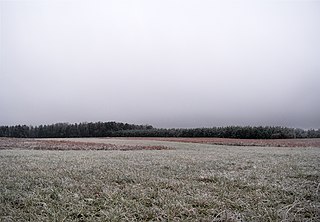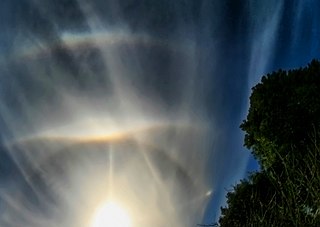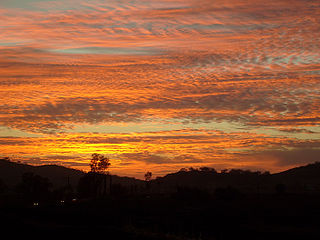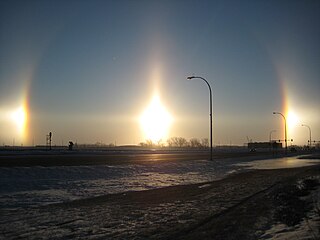
Stratus clouds are low-level clouds characterized by horizontal layering with a uniform base, as opposed to convective or cumuliform clouds that are formed by rising thermals. More specifically, the term stratus is used to describe flat, hazy, featureless clouds of low altitude varying in color from dark gray to nearly white. The word "stratus" comes from the Latin prefix "strato-", meaning "layer". Stratus clouds may produce a light drizzle or a small amount of snow. These clouds are essentially above-ground fog formed either through the lifting of morning fog or through cold air moving at low altitudes over a region. Some call these clouds "high fog" for the fog-like cloud. While light rain may fall, this cloud does not indicate much meteorological activity.

The antisolar point is the abstract point on the celestial sphere directly opposite of the Sun from an observer's perspective. This means that the antisolar point lies above the horizon when the Sun is below it, and vice versa. On a sunny day, the antisolar point can be easily found; it is located within the shadow of the observer's head. Like the zenith and nadir, the antisolar point is not fixed in three-dimensional space, but is defined relative to the observer. Each observer has their own antisolar point, which moves along with them as they change position.

An anthelion is a rare optical phenomenon of the halo family. It appears on the parhelic circle opposite to the sun as a faint white spot, not unlike a sundog, and may be crossed by an X-shaped pair of diffuse arcs.

A circumhorizontal arc is an optical phenomenon that belongs to the family of ice halos formed by the refraction of sun- or moonlight in plate-shaped ice crystals suspended in the atmosphere, typically in cirrus or cirrostratus clouds. In its full form, the arc has the appearance of a large, brightly spectrum-coloured band running parallel to the horizon, located far below the Sun or Moon. The distance between the arc and the Sun or Moon is twice as far as the common 22-degree halo. Often, when the halo-forming cloud is small or patchy, only fragments of the arc are seen. As with all halos, it can be caused by the Sun as well as the Moon.

The circumzenithal arc, also called the circumzenith arc (CZA), upside-down rainbow, and the Bravais arc, is an optical phenomenon similar in appearance to a rainbow, but belonging to the family of halos arising from refraction of sunlight through ice crystals, generally in cirrus or cirrostratus clouds, rather than from raindrops. The arc is located at a considerable distance above the sun and at most forms a quarter of a circle centered on the zenith. It has been called "a smile in the sky", its first impression being that of an upside-down rainbow. The CZA is one of the brightest and most colorful members of the halo family. Its colors, ranging from violet on top to red at the bottom, are purer than those of a rainbow because there is much less overlap in their formation.

A parhelic circle is a halo, an optical phenomenon appearing as a horizontal white line on the same altitude as the sun, or occasionally the Moon. If complete, it stretches all around the sky, but more commonly it only appears in sections.

A 22° halo is an optical phenomenon that belongs to the family of ice crystal halos, in the form of a ring with a radius of approximately 22° around the Sun or Moon. When visible around the moon, it is called a moon ring or winter halo. It forms as the sun- or moonlight is refracted in millions of hexagonal ice crystals suspended in the atmosphere. The halo is large; the radius is roughly the size of an outstretched hand at arm's length. A 22° halo may be visible on as many as 100 days per year—much more frequently than rainbows.

A supralateral arc is a comparatively rare member of the halo family which in its complete form appears as a large, faintly rainbow-colored band in a wide arc above the sun and appearing to encircle it, at about twice the distance as the familiar 22° halo. In reality, however, the supralateral arc does not form a circle and never reaches below the sun. When present, the supralateral arc touches the circumzenithal arc from below. As in all colored halos, the arc has its red side directed towards the sun, its blue part away from it.
An infralateral arc is a rare halo, an optical phenomenon appearing similar to a rainbow under a white parhelic circle. Together with the supralateral arc they are always located outside the seldom observable 46° halo, but in contrast to supralateral arcs, infralateral arcs are always located below the parhelic circle.

A 46° halo is a rare member of the family of ice crystal halos, appearing as a large ring centred on the Sun at roughly twice the distance as the much more common 22° halo. At solar elevations between 15–27°, the 46° halo is often confused with the less rare and more colourful supralateral and infralateral arcs, which cross the parhelic circle at about 46° to the left and right of the sun.

The subparhelic circle is a rare halo, an optical phenomenon located below the horizon. It passes through both the subsun, below the sun, and the antisolar point, opposite to the sun. The subparhelic circle is the subhorizon counterpart to the parhelic circle located above the horizon.
A Liljequist parhelion is a rare halo, an optical phenomenon in the form of a brightened spot on the parhelic circle approximately 150–160° from the sun; i.e., between the position of the 120° parhelion and the anthelion.

A Parry arc is a rare halo, an optical phenomenon which occasionally appears over a 22° halo together with an upper tangent arc.

Vädersolstavlan (help·info) is an oil-on-panel painting depicting a halo display, an atmospheric optical phenomenon, observed over Stockholm on 20 April 1535. It is named after the sun dogs appearing on the upper right part of the painting. While chiefly noted for being the oldest depiction of Stockholm in colour, it is arguably also the oldest Swedish landscape painting and the oldest depiction of sun dogs.
A subhelic arc is a rare halo, formed by internal reflection through ice crystals, that curves upwards from the horizon and touches the tricker arc above the anthelic point. Subhelic arcs are a result of ray entrance and exit through prism end faces with two intermediate internal reflections.

Atmospheric optics is "the study of the optical characteristics of the atmosphere or products of atmospheric processes .... [including] temporal and spatial resolutions beyond those discernible with the naked eye". Meteorological optics is "that part of atmospheric optics concerned with the study of patterns observable with the naked eye". Nevertheless, the two terms are sometimes used interchangeably.
A Lowitz arc is an optical phenomenon that occurs in the atmosphere; specifically, it is a rare type of ice crystal halo that forms a luminous arc which extends inwards from a sun dog (parhelion) and may continue above or below the sun.


















